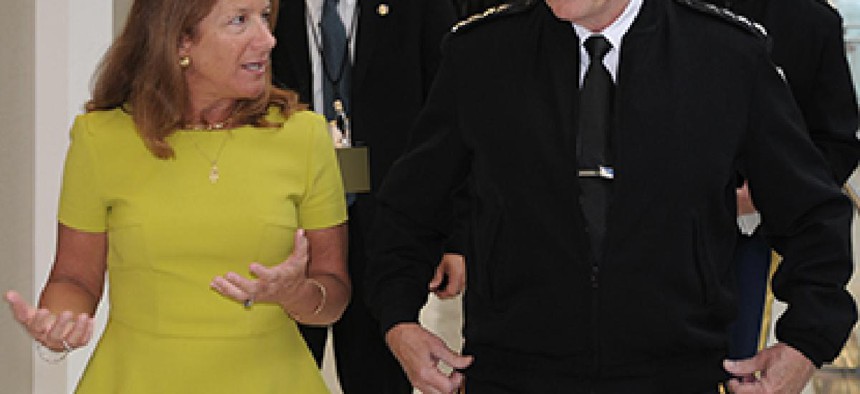NGA's Long on transparency, the workforce and the power of GEOINT

The first woman to head a major U.S. intelligence agency goes on the record about the highs and lows of the job.

National Geospatial-Intelligence Agency Director Letitia Long, shown here with Chairman of the Joint Chiefs of Staff Martin Dempsey on Sept. 3, is retiring in October after three decades of intelligence work. (Photo: NGA)
National Geospatial-Intelligence Agency Director Letitia Long's voice was hurting, and she still had 50 minutes of intermittent public speaking to go.
The intelligence community, she said hoarsely, is "working to retain the best that we can, to keep them challenged [and] to keep morale up" -- all against the backdrop of government gridlock and public skepticism.
Her gravelly voice perhaps dramatized the moment, but the first woman to head a major U.S. intelligence agency stood out in more ways than one while sounding a familiar theme at a Sept. 18 panel discussion with her counterparts from the CIA, NSA and Defense Intelligence Agency. Clad in bright red and flanked by her male colleagues, Long told the cameras and the packed ballroom room that intelligence is by its nature an uncertain and never-ending business.
"We do our best to lay out the options, lay out the possibilities, what might occur, what could occur … but unambiguous warning would equal clairvoyance, which is not something we are," she said.
Short of clairvoyance, NGA has been using geospatial data to track the movements of Russian troops near the Ukrainian border, she added, touting the agency's work in a way that intelligence chiefs are often reluctant to because of the secrets of the craft.
Long might be less recognizable to the American public than the CIA or NSA director who sat on either side of her, but her role in intelligence gathering is far out of proportion to name recognition. For more than four years, she has headed the agency responsible for harvesting intelligence from geospatial sources. Long's agency has come to the fore in the intelligence community's response to the leaks of classified information by former NSA contractor Edward Snowden and then-Pfc. Bradley Manning. Director of National Intelligence James Clapper said in April that because geospatial intelligence, or GEOINT, is the "most transparent of all of our intelligence endeavors," the IC will likely use it more in the post-Snowden era.
"We're a bit unique in that part of our mission set is unclassified," Long said in a recent interview with FCW. "Therefore, we can be more transparent. So that enables us to talk about what we do."
The agency lent its geospatial analytics to the humanitarian responses to the 2013 typhoon in the Philippines and to Hurricane Sandy in 2012. Because this work often taps unclassified satellite imagery, NGA can share its contributions with the public, going into more detail than the NSA and CIA chiefs ever do on operations.
Women and the IC
Long's Sept. 18 public appearance will be one of her last as NGA director – she will retire next month after a more than three-decade career in intelligence.
When asked to name the biggest regret of her tenure as NGA director, Long said the furloughs triggered by last year's government shutdown were "without a doubt the lowest point not only of my tenure as director [but of] my entire federal career." The furloughs constrained the IC's ability to do its job: DNI Clapper told the Senate last October that furloughs had affected about 70 percent of the civilian intelligence workforce.
As her tenure comes to a close, Long said she plans to take half a year or so to spend time with family and decompress, but her work with the IC is likely far from finished. If and when she gets involved again in intelligence issues, it will be to focus on "leader development as well as women in STEM [science, technology, engineering and mathematics]," she said.
As the first female head of a major U.S. intelligence agency, Long said she has cracked but not broken the glass ceiling. "We are not yet represented in the senior ranks across the intelligence community relative to our representation in the community," she said. But as she pointed out, there are other high-ranking female intelligence officials such as National Reconnaissance Office Director Betty Sapp and Deputy CIA Director Avril Haines.
Long said recruitment and flexible work policies are in place to encourage women to join the intelligence community. "I believe a number of women are in the positions they're in today because of previous leadership [and] because of some current leadership, namely Director of National Intelligence James Clapper, being focused on ensuring the same opportunities were available to women," she said.





